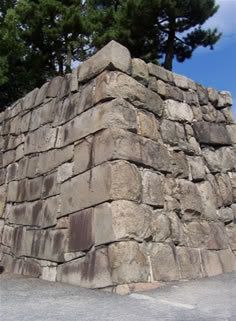The Golden Temple of Kinkaku-ji
It seems that the desire to outdo your neighbour is a pretty universal thing. Whether it's buying a fancier car, having an extension built, or covering your temple with gold, getting that edge over your rivals is something that is sought the world over. When Shogun Ashikaga Yoshimitsu planned a retirement villa in 1397, gold was the obvious choice for an outside colour scheme. Constructed on a reflecting lake, the Golden Temple of Kinkaku-ji is one of Japan's best-known sights. As expected, everything in the temple grounds is simply yet perfectly arranged, to maximise the visual impact. The care taken with these historic sights is wonderfully obsessive - at every temple or shrine we've seen countless gardeners, crowd directors, cleaners, and ticket inspectors. What we often can`t find are information guides - my Lonely Planet devotes two paragraphs to Kinkaku-ji, and there were no English maps available so we were reduced to wandering around guessing as to what it all meant, which was sad as the temple was breath-taking. The one piece of information I did find out was that the current temple above was built only in 1955 - a monk so obsessed with it's beauty burned it to the ground in 1950, presumably to stop others from looking at it.
The Zen rock garden at Ryoan-ji
The frustrations that we felt at Kinkaku-ji are universal at Ryoan-ji. The highlight of this Zen temple (founded in 1450) is the garden. Not just a regular garden, Ryoan-ji has the quintessential Buddhist rock and gravel garden. About the size of half a tennis court, the garden consists of 15 rocks adrift in a sea of carefully-raked gravel. The Japanese don't know what it means, as the designer - who remains unknown - never explained what the meaning was. One thing that is apparent is that no matter where you stand, you can't see all 15 rocks - at least one is always hidden.
Detail of a wall at Nijo Castle
The next stop for me was Nijo Castle. I'd wanted to look at a non-religious old building - and Nijo-jo was constructed in 1603 by one of the most infamous of all Shoguns - Tokugawa Ieyasu. Tokugawa came to power in 1600 and moved the capital to Edo (present-day Tokyo). He introduced a strict regime, took control of ports, mines and cities, and closed the entire country to foreigners. For the next 268yrs Japan developed in complete isolation. Any Japanese who ventured abraod were executed immediately if they returned.
Obviously being an important figure Tokugawa had his enemies. He met rival warlords at Nijo Castle in specially-designed rooms. You can walk around (but not inside) these today, and see exactly where these supressed nobles knelt to pay their respects to the Shogun. Wary of assassins, Tokugawa had the floor constructed so that every footstep produces a squeak. Tiny hooked pins under each floorboard rub against eachother, making it impossible to creep silently through the corridors - they are known as 'Nightingale' floors. Also in the castle are fake sections of wall made from thin paper that show the shadow of any would-be assailant, trapdoors in the ceiling for armed guards to leap from - and in the long meeting hall itself, the Shogun would sit at the far end next to a secret door. Inside were heavily-armed Samurai, ready to spring from hiding and defend their master from any surprise attackers. These methods must have been efficient - as despite a life filled with bloodshed and slaughter, Tokugawa died of natural causes in his sleep, aged 74.